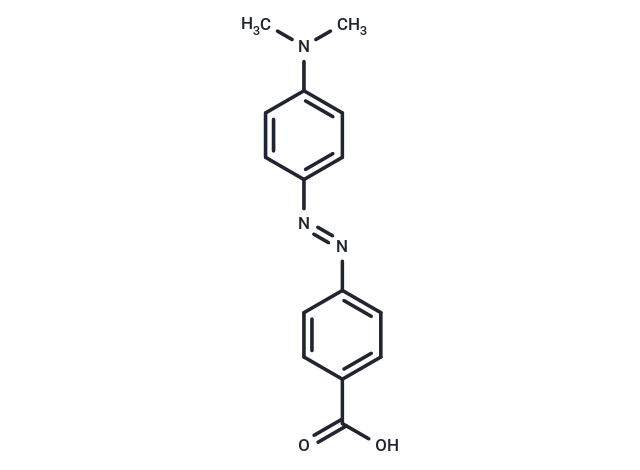Shopping Cart
Remove All Your shopping cart is currently empty
Your shopping cart is currently empty
Dabcyl acid (DABCYL) is the original dark fluorescence quencher.

| Pack Size | Price | USA Warehouse | Global Warehouse | Quantity |
|---|---|---|---|---|
| 1 g | $29 | In Stock | In Stock | |
| 1 mL x 10 mM (in DMSO) | $29 | In Stock | In Stock |
| Description | Dabcyl acid (DABCYL) is the original dark fluorescence quencher. |
| Cell Research | I. Fluorescence resonance energy transfer (FRET) experiment a. Reagent preparation: synthesize or purchase DABCYL-labeled donor molecules and matching fluorophore-labeled acceptor molecules, such as FITC, etc. Prepare appropriate buffer, such as PBS, etc. b. Experimental steps: 1. Dissolve the labeled donor and acceptor molecules in buffer respectively to prepare solutions of appropriate concentrations. 2. Add appropriate amounts of donor solution and acceptor solution to the cuvette or fluorescence enzyme labeling plate in sequence to make the final concentrations of the two meet the experimental design requirements, such as 10 nM for the donor concentration and 20 nM for the acceptor concentration. 3. Use a fluorescence spectrometer to set the appropriate excitation wavelength and emission wavelength range, first scan the fluorescence spectra of the donor and acceptor separately, and then scan the fluorescence spectrum of the mixture of the two, and observe the FRET phenomenon, that is, the decrease in the fluorescence intensity of the donor and the increase in the fluorescence intensity of the acceptor. II. Protein labeling and activity detection experiment a. Reagent preparation: Dissolve DABCYL-NHS ester in an anhydrous organic solvent such as DMF or DMSO. Prepare a solution of a certain concentration. Prepare the protein solution to be labeled and place it in a suitable buffer, such as Tris-HCl buffer. b. Experimental steps: 1. Take an appropriate amount of protein solution and slowly add DABCYL-NHS ester solution to make the molar ratio of DABCYL to protein reach a predetermined value, such as 1:5, etc., and stir the reaction at room temperature or 4°C for 1-2 hours. 2. After the reaction, remove the unreacted DABCYL by dialysis or gel filtration. 3. The labeled protein can be tested for its labeling efficiency by SDS-PAGE and other methods, and corresponding activity tests, such as enzyme activity assays, can be performed to evaluate the effect of labeling on protein activity. III. Cell uptake experiment a. Reagent preparation: Synthesize DABCYL-labeled cell penetrating peptides or other carrier molecules and dissolve them in cell culture medium or PBS. Prepare the corresponding cell line, such as HeLa Cells, etc., and culture to the logarithmic growth phase. b. Experimental steps: 1. Inoculate the cells in the culture plate and culture to the appropriate density. 2. Add a solution containing DABCYL labeled molecules to make the final concentration reach the set value, such as 10 μM, etc., and incubate in a 37℃, 5% CO₂ incubator for a certain time, such as 1-4 hours. 3. After the incubation, wash the cells with PBS to remove the unabsorbed labeled molecules. 4. The fluorescence distribution in the cells can be observed by fluorescence microscopy, or the cell uptake of DABCYL labeled molecules can be quantitatively analyzed using flow cytometry. |
| Synonyms | Para-methyl red, DABCYL |
| Molecular Weight | 269.3 |
| Formula | C15H15N3O2 |
| Cas No. | 6268-49-1 |
| Smiles | CN(C)c1ccc(cc1)\N=N\c1ccc(cc1)C(O)=O |
| Relative Density. | 1.17g/cm3 |
| Storage | keep away from direct sunlight | Powder: -20°C for 3 years | In solvent: -80°C for 1 year | Shipping with blue ice/Shipping at ambient temperature. | ||||||||||||||||||||||||||||||
| Solubility Information | DMSO: 25 mg/mL (92.83 mM), Sonication is recommended. | ||||||||||||||||||||||||||||||
Solution Preparation Table | |||||||||||||||||||||||||||||||
DMSO
| |||||||||||||||||||||||||||||||
| Size | Quantity | Unit Price | Amount | Operation |
|---|

Copyright © 2015-2026 TargetMol Chemicals Inc. All Rights Reserved.